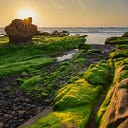One of the most unique landscapes on the planet- “The Water Pocket Fold” take an adventurous tour to another planet
The Water pocket Fold is one of the most amazing landscapes on the planet. Capitol Reef National park is America known to everyone, mainly because of the magnificent Water pocket Fold. Water pocket is a 160-km-long, monocline sharp fold of Earth’s crust that was formed when thick layers of horizontal sedimentary rocks mainly Sandstones, shales, mudstones, and limestone’s had been deposited in the region. The Water pocket Fold extends from southern Wayne and ending in northern Kane counties of southern Utah, United States.
Geology
This Long Fold belt creating the most outstanding geological feature on the earth. The landscape of rugged cliffs and canyons, striking natural bridges, arches, and other distinct formations make the landscape unique in the region. This warp in the Earth’s crust is a classic monocline fold. A monocline is essentially a single fold in rock strata. Water Pocket fold formed between 50- 70 million years ago when a major mountain building process ‘Laramide orogeny’ reactivated in a fault zone in western North America. Movement along the fault caused the west side to shift upwards relative to the east side.
The overlying sedimentary layers were exposed above the fault and formed a monocline. The rock layers on the west side of the fold have been lifted more than 2,134 m higher than the layers on the east. Water pocket owes its name to deep potholes found in the canyons that can hold water for years. Recent uplift of the entire Colorado Plateau and the resulting erosion has exposed this fold at the surface within the last 15 to 20 million years.
Parallel ridges of the Fold rise from the desert like the swell of giant waves rolling toward the shore. Capitol Reef is named for a particularly colorful section of the fold where rounded Navajo sandstone forms capitol-like domes and sheer cliffs. These cliffs form a barrier to travel and often referred to as a “reef.”Cathedral Valley, at the northwestern boundary, is the lower end of the incline, highlighted by deep erosion and free-standing tower-like sandstone monoliths. The vast Bentonite Hills roll at the southern end of the park.
Other Scenic feature
Parallel to the Water pocket Fold, there is the Notom-Bullfrog Road. There are many trailheads and gorgeous vistas from the Notom-Bullfrog Road. For a breath-taking backdrop, you can take the Burr Trail, which cuts across the Fold. Hiking and horseback riding are popular from Burr Trail; here visitors can see natural bridges, sandstone arches, and other majestic formations.
Notom-Bullfrog Road is some significant places, such as Burro Wash, Sheets Gulch slot canyons, and Cottonwood Wash. These canyons are clustered together, making the area a popular destination for hikers.
Also read- Amazing Rock formation “Kasha Katuwe Tent Rocks” — A Great Geological Monument in New Mexico
Lower Muley Twist Canyon is well-famous for hikers. Its narrow, deep, contorted canyon trailhead is found at top of the Burr Trail. Upper Muley Twist Canyon displays dramatic views of the Water pocket Fold. Here visitors can see the rock that has been eroded into strange formations, like huge arches. Along the Notom-Bullfrog Road, there are five camping sites, where visitors can stay and take an adventurous view of the surrounding landscape.
Scenic Highway 24 runs through the heart of the park and is the only paved road that crosses the rugged terrain of the Water pocket Fold. There are tons of slot canyons and trails to be explored in Capitol Reef.
The nearest airport to the Capitol reef national park in Salt Lake City. For a scenic approach to the National park, the visitors start at Bryce Canyon National Park and Follows Utah 12 over Boulder Mountain to Utah 24.
